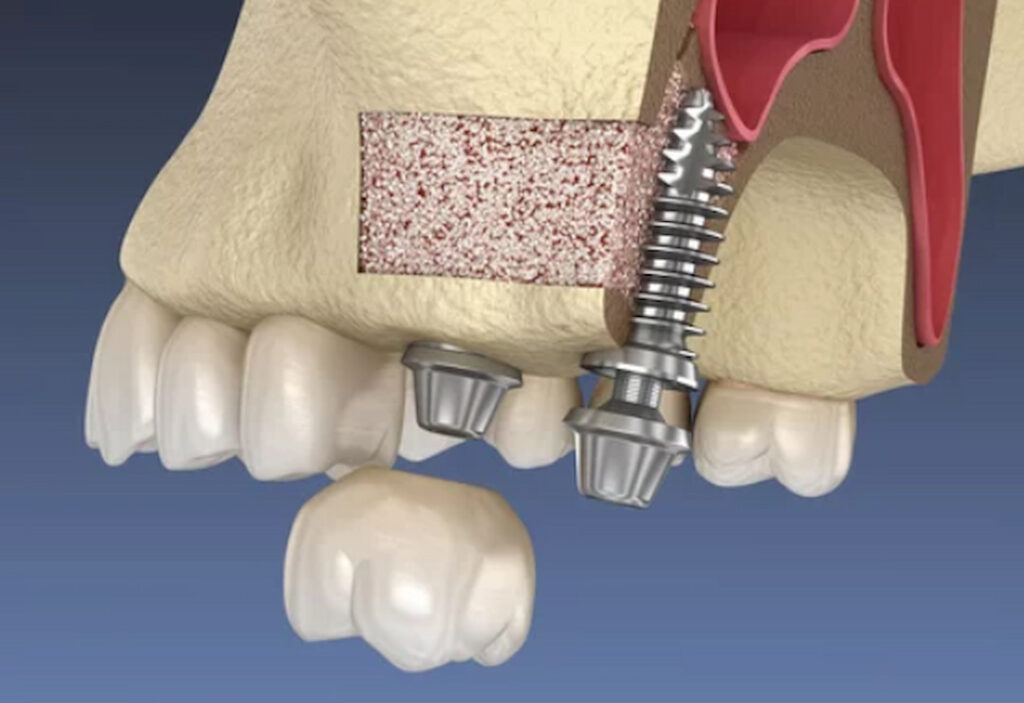
Dental implants are a very simple concept with a highly complex execution. They are used to help replace natural teeth with false teeth that function in a nearly-identical way. Many people are unaware, however, of the difference in difficulty between installing dental implants on the upper jaw vs. getting them on the lower jaw.
The difference is significant, and in some ways, it may even be the reason that someone is deemed ineligible for dental implants. Bone loss on the upper jaw can be considerable, and if it’s not addressed with the proper grafting techniques then it could lead to being unable to anchor the implants sufficiently.
Getting An Entire Upper Jaw Of Dental Implants
Patients that have lost all of their upper teeth have lost noticeable enjoyment in their life, and often intensely dislike wearing full sets of dentures. The biggest complaints of those that get a full arch denture, or a full set of dentures include:
- Increased difficulty speaking and eating dextrously
- Lacking taste in many of their favorite foods due to their palate being covered with a large piece of acrylic
- A feeling of being perceived as older, which happens because dentures are often associated with the elderly
Getting an entire upper jaw of dental implants isn’t that uncommon, but the upper jaw is often considered far more challenging when it comes to things like bone loss and grafting. There is much less bone in the middle of our faces than many people realize, which means there is very little bone above our upper jaw, to begin with. If this already sparse bone distribution is diminished, the options for grafting are relatively limited, with few alternative options.
While there are some grafting methods specifically for the upper jaw, if the bone loss has been determined to be too severe, there may not be enough bone for the graft to stick to and osseointegrate with. This means in situations where grafts aren’t a possibility, the patient may be able to use “rescue implants”, which screw into the cheekbones after passing through the jaw.

Can Patients With No Teeth Get Dental Implants?
Patients with no teeth are often able to get some form of dental implant. They do face some additional risks, however, and if they have been without teeth for too long, the risks may be too great for safe implant installation. The biggest risk comes from the potential for extensive bone loss in those that have lost all of their teeth or had them all extracted.
When a single tooth is removed, the work that tooth was doing no goes undone. Sure this means the usual biting and chewing work, but that tooth was also doing a much more tedious job. It was keeping other things, like teeth and the bone of your jaw, from moving around. This problem gets magnified and exacerbated when more teeth come out, and eventually, when you have no more teeth, the bone of your jaw is free to move around.
Some of that bone, as much as 25% over the first year of no teeth, will diminish in density and volume. If too much of that bone disappears, there won’t be enough area to install the anchors without bone grafts. There will be another bone loss threshold where not only is the bone loss serious enough to preclude dental implants, but it will be too serious to allow the use of bone grafts as well.
Some Bone Loss Can Be Treated With Bone Grafts
There are many situations stemming from bone loss that can be fixed or remedied with dental implant bone grafts, but just how those potential solutions are leveraged will depend on a large number of variables your dentist will consider.
First of all, they will decide if the bone grafts are truly needed to get the implant operation successfully done. Then they will need to determine what type of grafts are going to be ideal for the application. They will generally choose from socket preservation, a sinus lift, or ridge augmentation.
Socket Preservation
Socket preservation is one of the most common bone grafts in the dental world. It is usually used immediately following tooth extraction and is used to help reinforce the jaw by preserving the density of the bone. Once the tooth has been removed, the socket is filled with a bone graft substance that helps the bone grow and fuse quicker.
Sinus Lift
A sinus lift is also known as a sinus augmentation and is usually used to help increase the bone available in the upper jaw. The graft is placed in such a way that bone loss in the jaw bone and maxillary sinus cavity are prevented and new bone is grown. During a sinus lift, the sinus cavity is raised into a higher position and the bone structure around it is built up but also made more uncertain.
Ridge Augmentation
Severe cases of bone loss may require a ridge augmentation, which is a type of bone graft that adds bone volume and mass to the entire ridge of the jaw bone. This can be the perfect solution for someone whose lost dentition has resulted in changed facial geometry and increased skin looseness. While filling out your jawline and correcting your facial geometry, the graft will also provide enough new volume to securely anchor the new dental implants.

Implants Helping Implants
In addition to the bone grafting process, other implants may help provide enough area for the artificial teeth roots to hold effectively. Zygomatic dental implants are dental implants that remove the need for bone grafting entirely. They are designed to be used with patients who have moderate to extreme resorption in their upper jaw.
Usually, in cases like this, the implants are placed in the jaw bone, to replace all the missing teeth in the maxilla. However, some patients have advanced bone loss beyond a threshold that allows the safe and secure placement of dental implant screws. There is the potential to use longer screws to anchor the implant into the cheekbone as an alternative.
The zygomatic implant anchoring does have some benefits over other implant strategies. There is only a single surgery to take care of, which means a quicker and easier recovery. As soon as the implants are installed, there is no need to wait for osseointegration and they can be loaded with teeth in most situations. There is no sinus lift or other bone graft needed, and following completion, the patient will be able to smile, bite and even chew their food with almost no changes from what they’re used to. Overall, the dental treatment timeline is shorter than with traditional implant plans.
These are often considered to be a last resort in the dental implant space and are even called “rescue implants” sometimes. This is because they act as a rescue when the patient is unable to utilize other bone graft options, sometimes due to excessive bone loss. Since they are so significantly anchored zygomatic implants are best used for fixed bridge types of implants.

What Is The Process For Getting Dental Implants?
Depending on your dentist and the work you need to be done, your implants may be incredibly simple, or they can be highly complex. The first part of the implant involves extracting the tooth or teeth that the implant will be replacing, and using a socket preservation graft to give the anchors something to hang on to.
The anchor is a post that is implanted, screwed into the jaw bone, and will affix the rest of the implant. Once the posts are installed and they have been given time to osseointegrate and heal, they are used as the primary attachment points for an individual false tooth, a partial bridge, or even a full dental bridge, which replaces all the teeth on either the upper or lower jaw.

